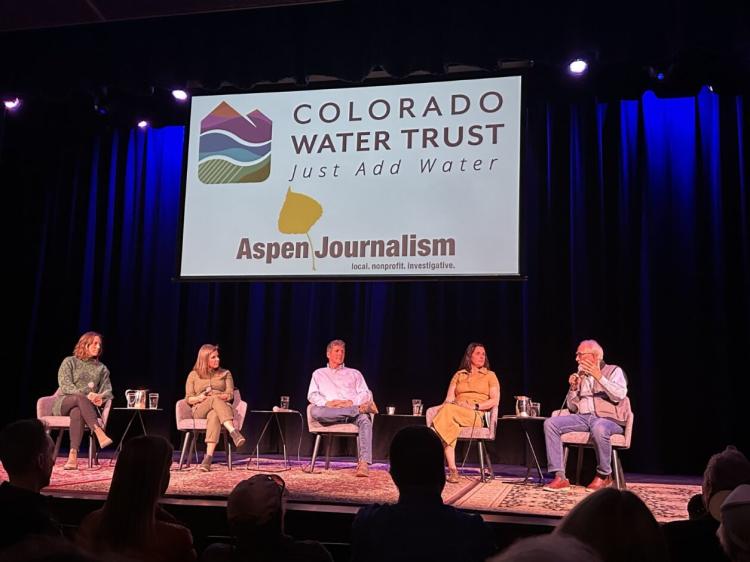
Aspen Journalism held an exciting panel in Basalt the evening of Tuesday April 9th. The event, “Hanging in the Balance: Competing Needs for Water in the West” hosted Kate Ryan, Executive Director of the Colorado Water Trust, Hattie Johnson, Restoration Director of American Whitewater’s Stweardship Program, Mark Harris, Senior Water Resources Consultant for SGM Engineers & Consultants, and Andy Mueller, General Manager of the Colorado River Water Conservation District.
The Panel was hosted by Heather Sackett the editor and lead reporter for Aspen Journalism’s Water Desk. Sackett pressed the speakers on the various ways they are working together to support water users across the west.
Kate Ryan and Andy Mueller discussed how government entities and non-profit organizations have been working together to provide water in the face of climate change. Mueller pointed to the Shoshone project which purchased a water right from Xcel to help provide in-stream flows for the Colorado River. This project has draw support from over 40 entites looking to provide benefits to the environment, agriculture industry, and recreation economies.
Hattie Johnson discussed about how recreation factors into how Colorado balances water supply and demand. “Recreation accounts for a large portion of the Colorado economy and provides multiple benefits for both environmental and agricultural users.” In addition, Johnson discussed how recreation is one of the newer beneficial uses of water. In 2001, the Colorado Legislature passed a bill allowing for Recreational In-Channel Diversions (RICDs). Before that time, the only entites that could acquire an in-channel diversion were the Colorado Water Conservation Board, and any local water conservancy districts. Now towns like Vail, Breckenridge, and Glenwood Springs all have RICDs that provide world-class whitewater rafting opportunities. Recreational rights also provide great opportunities for collaboration with entities like the Colorado Water Trust and the agricultural community because they leave water in the river. Leaving water in the river helps with environmental flows, junior water users, and allows us to meet compact requirements for the Colorado River.
Mark Harris highlighted the balance between agricultural and municipal water. Many agricultural users are beginning to work with municipal providers to work through augmentation plans or water sharing agreements that compensate for voluntary redictions in water use
Sackett pressed Harris on whether farmers should expect to “sacrifice” in the future given our current need to reduce our water consumption. “Farmers might have to give up something, but before any person is expected to be curtailed either voluntarilay or not, we need to have a serious discussion about how we are going to achieve that in a manner built upon local needs and solutions,” said Harris.
Harris also taked about how the agricultural community is actively looking for ways to conserve water. One potential solution is to work with state agencies or water conservancy districts to provide funding for water infrastructure upgrades. The River District Mueller runs has been providing funding for years to prioritize projects with multiple beneficiaries. “I can’t really think of a project that only has one beneficiary. Even lining a ditch to conserve water for an individual farming operation helps put more water in the river and can help benefit the endangered species on the Colorado River,” said Mueller.
Audience members also highlighted important topics for the panel such as how soil health plays a role in the conservation of water and how speculation is beginning to hinder the development of our states water resources.
Overall, the panel seemed optimistic about the current balance of water supply planning within the state but advocated for greater collaboration. “We need to begin having these tough conversations internally. If we wait unitl we are forced to have external conversations we may not be prepared,” said Mark Harris. However, the balance of our water supply is ultimately in our hands and will require education, collaboration, and a lot of hard work to achieve.
